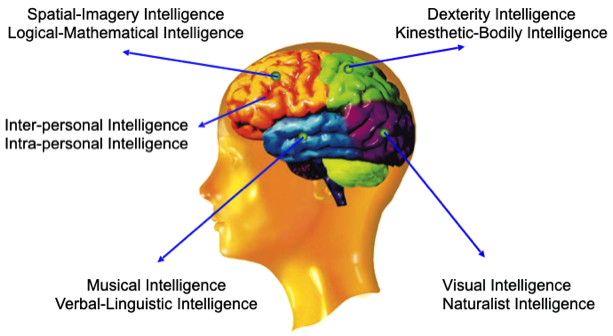Multiple Intelligence
The theory of multiple intelligences was developed in 1983 by Dr. Howard Gardner, professor of education at Harvard University. It suggests that the traditional notion of intelligence, based on I.Q. testing, is far too limited. Instead, Dr. Gardner proposes eight different intelligences to account for a broader range of human potential in children and adults. These intelligences are:
• Linguistic Intelligence (Word Smart)
• Logical-Mathematical Intelligence (Number/rRasoning Smart)
• Spatial Intelligence (Picture Smart)
• Bodily-Kinesthetic Intelligence (Body Smart")
• Musical Intelligence (Music Smart)
• Interpersonal Intelligence (People Smart)
• Intrapersonal Intelligence (Self Smart)
• Naturalist Intelligence (Nature Smart)
Dr. Gardner says that our schools and culture focus most of their attention on linguistic and logical-mathematical intelligence. We esteem the highly articulate or logical people of our culture.
However, Dr. Gardner says that we should also place equal attention on individuals who show gifts in the other intelligences: the artists, architects, musicians, naturalists, designers, dancers, therapists, entrepreneurs, and others who enrich the world in which we live. Unfortunately, many children who have these gifts don’t receive much reinforcement for them in school.
Many of these kids, in fact, end up being labeled "learning disabled," "ADD (attention deficit disorder," or simply underachievers, when their unique ways of thinking and learning aren’t addressed by a heavily linguistic or logical mathematical classroom.
The theory of multiple intelligences proposes a major transformation in the way our schools are run. It suggests that teachers be trained to present their lessons in a wide variety of ways using music, cooperative learning, art activities, role play, multimedia, field trips, inner reflection, and much more
The good news is that the theory of multiple intelligences has grabbed the attention of many educators around the country, and hundreds of schools are currently using its philosophy to redesign the way it educates children.
The bad new is that there are thousands of schools still out there that teach in the same old dull way, through dry lectures, and boring worksheets and textbooks.
The challenge is to get this information out to many more teachers, school administrators, and otherswho work with children, so that each child has the opportunity to learn in ways harmonious with their unique minds
The theory of multiple intelligences also has strong implications for adult learning and development. Many adults find themselves in jobs that do not make optimal use of their most highly developed intelligences (for example, the highly bodily-kinesthetic individual who is stuck in a linguistic or logical desk-job when he or she would be much happier in a job where they could move around, such as a recreational leader, a forest ranger, or physical therapist).
The theory of multiple intelligences gives adults a whole new way to look at their lives, examining potentials that they left behind in their childhood (such as a love for art or drama) but now have the opportunity to develop through courses, hobbies, or other programs of self-development.
How to Teach or Learn Anything 8 Different Ways
One of the most remarkable features of the theory of multiple intelligences is how it provides eight different potential pathways to learning.
If a teacher is having difficulty reaching a student in the more traditional linguistic or logical ways of instruction, the theory of multiple intelligences suggests several other ways in which the material might be presented to facilitate effective learning.
Whether you are a kindergarten teacher, a graduate school instructor, or an adult learner seeking better ways of pursuing self-study on any subject of interest, the same basic guidelines apply. Whatever you are teaching or learning, see how you might connect with.
For example, if you’re teaching or learning about the law of supply and demand in economics, you might read about it (linguistic), study mathematical formulas that express it (logical-mathematical), examine a graphic chart that illustrates the principle (spatial), observe the law in the natural world (naturalist) or in the human world of commerce (interpersonal); examine the law in terms of your own body [e.g. when you supply your body with lots of food, the hunger demand goes down; when there's very little supply, your stomach's demand for food goes way up and you get hungry] (bodily-kinesthetic and intrapersonal); and/or write a song (or find an existing song) that demonstrates the law (perhaps Dylan's "Too Much of Nothing?").
You don’t have to teach or learn something in all eight ways, just see what the possibilities are, and then decide which particular pathways interest you the most, or seem to be the most effective teaching or learning tools.
The theory of multiple intelligences is so intriguing because it expands our horizon of available teaching/learning tools beyond the conventional linguistic and logical methods used in most schools (e.g. lecture, textbooks, writing assignments, formulas, etc.).
To get started, put the topic of whatever you’re interested in teaching or learning about in thecenter of a blank sheet of paper, and draw eight straight lines or "spokes" radiating out from this topic. Label each line with a different intelligence.
Then start brainstorming ideas for teaching or learning that topic and writedown ideas next to each intelligence (this is a spatial-linguistic approach of brainstorming; you might want to do this in other ways as well, using a tape-recorder, having a group brainstorming session, etc.).
Have fun!


G-Code Consultancy
Decipher Your Genetic Code